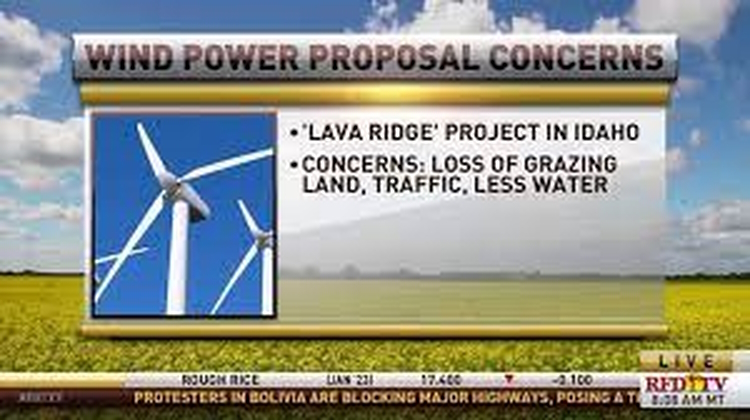
Is The BLM Violating Grazing Laws? Part 1
By Karen Schumacher
The Bureau of Land Management (BLM) Lava Ridge project is part of a clean energy agenda between government and corporate partnerships that will degrade Idaho land. Idaho is caught up in this agenda through LS Power which plans to bring wind turbines to the Magic Valley. When Magic Valley Energy (MVE) is mentioned, it is really LS Power talking, MVE is just its front name.
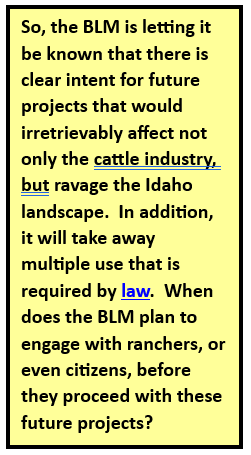 Several impact areas are addressed with this project, but there are two documents on the grazing issue: the Draft Environmental Impact Statement (DEIS), Livestock Grazing, Section 3.9 (page 3-273), and the Draft Appendix S: Grazing Coordination Plan (GCP) that will be covered in Part 2.
Several impact areas are addressed with this project, but there are two documents on the grazing issue: the Draft Environmental Impact Statement (DEIS), Livestock Grazing, Section 3.9 (page 3-273), and the Draft Appendix S: Grazing Coordination Plan (GCP) that will be covered in Part 2.
Part 1 will look first at the DEIS analysis in Section 9, page 3-273, where it was determined that the impacts on livestock management would occur during “construction through decommissioning (34 years) plus time for livestock forage to reestablish after final reclamation (estimated to be up to 5 years…).” Thirty-nine years of disruption to the cattle industry over Jerome, Lincoln, and Minidoka Counties, with land destruction taking years to heal. What is the economic impact of that?
Page 3-278 states, “future development in the analysis area is likely to include construction of the SWIP–North transmission line and construction of the Gateway West transmission line…These projects would add more roads, fences, transmission lines, and human activity to the analysis area. The Invenergy Gem Vale solar facility would be just north of the Midpoint Substation on approximately 3,500 acres. Two Longroad Energy solar facilities would cover 3,200 acres each just east of U.S. 93 and south of (connecting to) the Midpoint Substation. All the solar facilities would have fencing surrounding the facilities…These trends and activities could cause changes in forage conditions, altering the forage availability for livestock grazing and altering existing range improvements.” This would be in addition to the proposed Salmon Falls Wind Project and Taurus Wind Project.
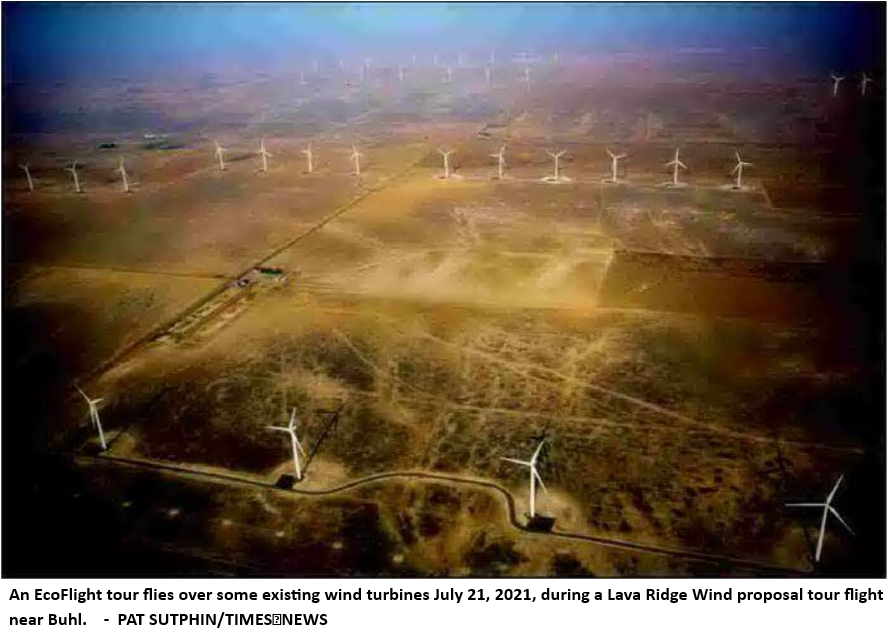
So the BLM is letting it be known that there is clear intent for future projects that would irretrievably affect not only the cattle industry, but ravage the Idaho landscape. In addition, it will take away multiple use that is required by law. When does the BLM plan to engage with ranchers, or even citizens, before they proceed with these future projects?
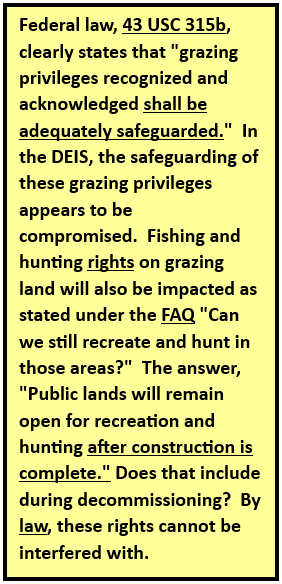 On page 3-273 it states grazing permits would not be modified during this analysis, “If part of the action alternatives would require modifications to grazing permits, this would be addressed in a subsequent NEPA analysis and permit actions.” That is illogical as those permits involve allotments and AUMs, and essentially the current DEIS proposes modifications to grazing permits in this project. Allotments are parcels of land in grazing permits, and AUM stands for Animal Unit Months, the term used to describe “amount of forage needed by an “animal unit” (AU) grazing for one month.”
On page 3-273 it states grazing permits would not be modified during this analysis, “If part of the action alternatives would require modifications to grazing permits, this would be addressed in a subsequent NEPA analysis and permit actions.” That is illogical as those permits involve allotments and AUMs, and essentially the current DEIS proposes modifications to grazing permits in this project. Allotments are parcels of land in grazing permits, and AUM stands for Animal Unit Months, the term used to describe “amount of forage needed by an “animal unit” (AU) grazing for one month.”
Is the BLM and MVE saying in the NEPA analysis that grazing permits are under threat of permanent modification? Unacceptable because federal law protects grazing permits and rights.
43 USC 315b states holders of grazing permits “are entitled to participate in the use of the range.” MVE is suggesting that those entitlements granted in permits can be altered or removed, and as will be seen, are being modified, which appears to be violating this law. Are MVE and the BLM also implying that future permit renewals and new permits will not be granted?
43 US Code 315o-1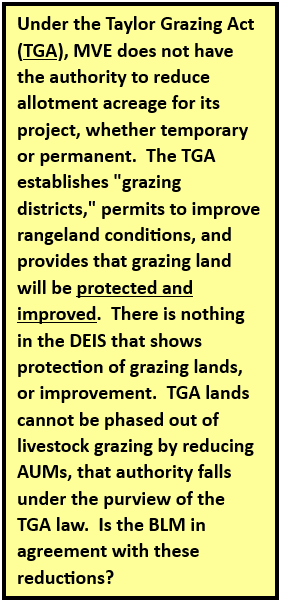 outlines the requirement for an “advisory board of local stockmen in each such district” and offer advice on “any other matters affecting the administration of this subchapter within the district.” Both BLM and MVE have a clear obligation to engage these local advisory boards if they exist, and ranchers, on any projects, current or future, and the impact it will have on grazing districts and permits. A few select individuals were placed on a subcommittee by the BLM to accomplish this task and who have recommended denial of this project.
outlines the requirement for an “advisory board of local stockmen in each such district” and offer advice on “any other matters affecting the administration of this subchapter within the district.” Both BLM and MVE have a clear obligation to engage these local advisory boards if they exist, and ranchers, on any projects, current or future, and the impact it will have on grazing districts and permits. A few select individuals were placed on a subcommittee by the BLM to accomplish this task and who have recommended denial of this project.
Federal law, 43 USC 315b, clearly states that “grazing privileges recognized and acknowledged shall be adequately safeguarded.” In the DEIS, the safeguarding of these grazing privileges appears to be compromised. Fishing and hunting rights on grazing land will also be impacted as stated under the FAQ “Can we still recreate and hunt in those areas?” The answer, “Public lands will remain open for recreation and hunting after construction is complete.” Does that include during decommissioning? By law, these rights cannot be interfered with.
On page 3-285 it reiterates, “An irretrievable commitment of grazing resources and effects to the local grazing economy would occur over the 34-year life of the project, plus time for livestock forage to reestablish after final reclamation (estimated to be up to 5 years). Grazing permittees would experience both temporary…and long-term…AUM reductions.” “BLM grazing allotments would be subject to long-term reductions in allotment acreage…some areas could remain permanently unavailable.” This is a direct threat to the cattle industry in Magic Valley. It is no wonder since the cattle industry is already under attack, one reason being climate change. Maybe ranchers should just put masks on their cattle.
Under the Taylor Grazing Act (TGA), MVE does not have the authority to reduce allotment acreage for its project, whether temporary or permanent. The TGA establishes “grazing districts,” permits to improve rangeland conditions, and provides that grazing land will be protected and improved. There is nothing in the DEIS that shows protection of grazing lands, or improvement. TGA lands cannot be phased out of livestock grazing by reducing AUMs, that authority falls under the purview of the TGA law. Is the BLM in agreement with these reductions?
Page 3-277 in the DEIS states, “The project would intersect up to nine BLM public land grazing allotments depending on the action alternative.” Intersecting these allotments means the cattle will be cut off from grazing and water in the allotment. Permits, allotments, and AMUs are written into federal law for protection. Does this violate the following laws?
43 CFR § 4130.2(e)(1) – “The lands for which the permit or lease is issued remain available for domestic livestock grazing;” clearly the land will not be available for grazing in this project.
43 CFR § 4130.3-2(f) – “Provision for livestock grazing temporarily to be delayed” can be done for various reasons but wind projects are not listed as a reason, and 39 years isn’t really temporary.
43 USC 315b – “grazing privileges recognized and acknowledged shall be adequately safeguarded.” Grazing privileges that are part of permits are not being safeguarded in this proposed project. Reduction of allotments and AMUs prevent the full attainment of grazing privileges.
43 U.S. Code § 315a – The Secretary of Interior shall “preserve the land and its resources from destruction or unnecessary injury, to provide for the orderly use.” Is the Lava Ridge project causing destruction and unnecessary injury?
The Public Rangelands Improvement Act of 1978 (43 U.S.C. 1901(b)(2)) will “manage, maintain and improve the condition of the public rangelands so that they become as productive as feasible for all rangeland values in accordance with management objectives and the land use planning process established pursuant to section 1712 of this title.” Were ranchers given “adequate notice and opportunity to comment upon and participate in the formulation of plans and programs relating to the management of the public lands” they use for grazing (f)? Or was a consulting firm paid by MVE for the formulation of a plan? MVE was incorporated in 2019. Were ranchers notified then about the future threats to their grazing rights with the rangeland being degraded? This project does not improve any rangeland it impacts.
40 CFR 1508.27(b)(7) “Significance cannot be avoided by terming an action temporary or by breaking it down into small component parts.” With the ongoing construction and removal of temporary fencing, creating smaller areas of disruption one at a time, the overall significant impact of these mitigation measures cannot be lessened.
The burden is on BLM to demonstrate what allows them to violate these laws, and should be challenged on these potential violations. There should be no compromises between MVE and the ranchers on these issues. Even more stunning, why did the BLM even let this impact on grazing rights get so far?
To listen to the BLM Resource Advisory Council Subcommittee comments on the grazing impacts go to the 1’43” mark in this video. The BLM is violating other federal laws that mandate Coordination, and are circumventing these laws by placing county commissioners and some ranchers on a subcommittee when it should be initiating Coordination. But the BLM knows this and instead are distracting from the law by concocting an appearance of collaborating with local governments. Coordination is not consulting or collaborating, and will be covered further in Part 2.
Part 2 will scrutinize the Grazing Coordination Plan for its possible violations of federal law on grazing rights, which is not the same as Coordination mentioned above. Share this information with cattle ranchers for their thoughts. Here is the link to give comments, just press the green “Participate Now” button on the left, or email BLM_ID_LavaRidge@blm.gov by April 20,2023. Demand that the BLM select Alternative A, No Action (page 2-1). Stand with the ranchers in Magic Valley and do it for all of Idaho.